Detailed Analysis of Software Testing and Documentation Process
VerifiedAdded on 2023/03/23
|16
|2799
|68
Report
AI Summary
This document presents a comprehensive software testing report, focusing on the testing of an online backstage management system. It includes a system overview, test approach encompassing unit, integration, and user acceptance testing, a detailed test plan outlining features to be tested and excluded, testing tools and environment, and a traceability matrix. The report also provides specific test cases with defined purposes, inputs, expected outputs, pass/fail criteria, and test procedures. Furthermore, it includes a Gantt chart for project timelines, a budget breakdown for testing activities, and test logs documenting the results and incident reports. The objective is to ensure the software meets business requirements, reduces errors, and provides a user-friendly interface, with early identification and resolution of defects to enhance performance, usability, security, and maintainability.
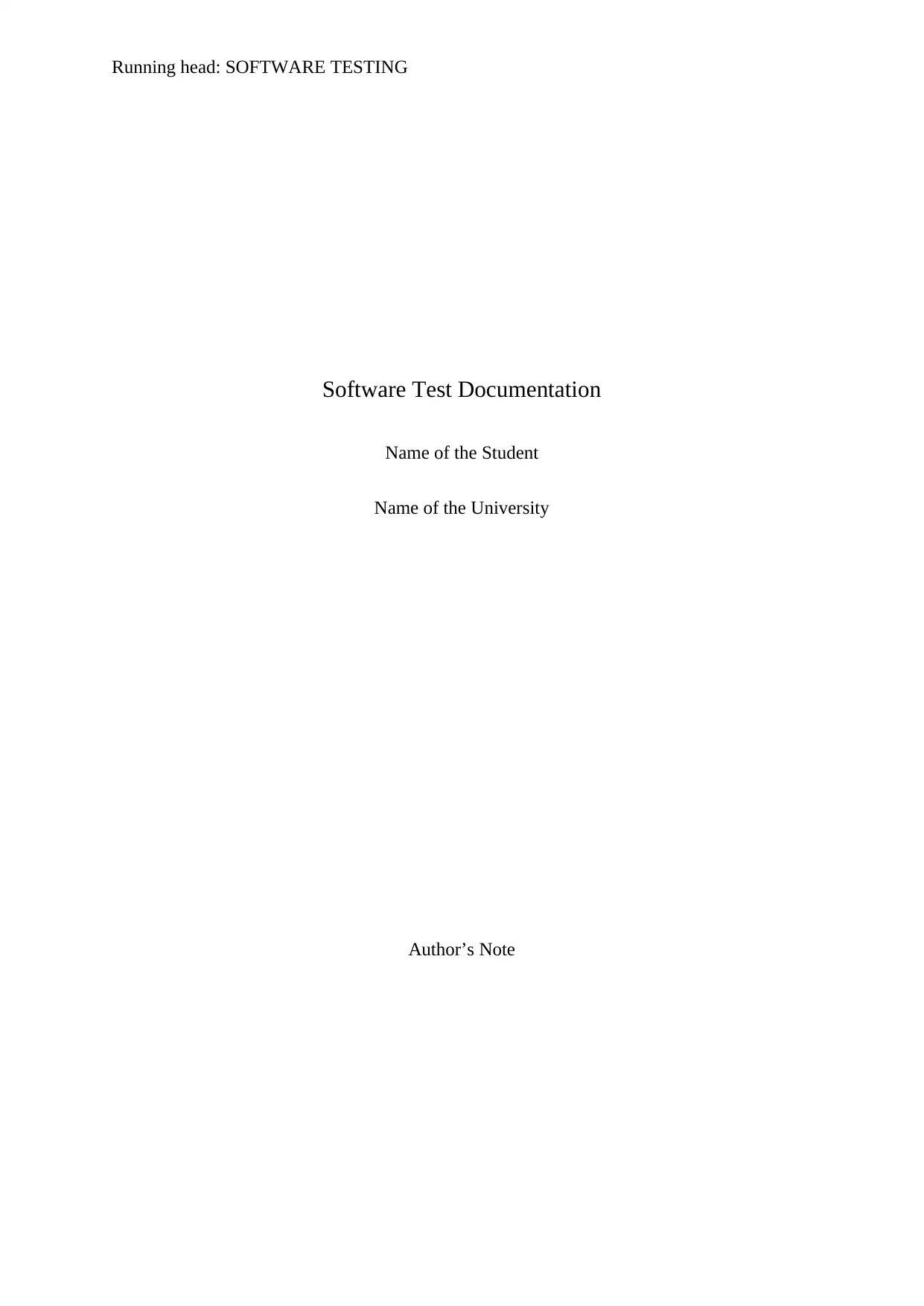
Running head: SOFTWARE TESTING
Software Test Documentation
Name of the Student
Name of the University
Author’s Note
Software Test Documentation
Name of the Student
Name of the University
Author’s Note
Paraphrase This Document
Need a fresh take? Get an instant paraphrase of this document with our AI Paraphraser
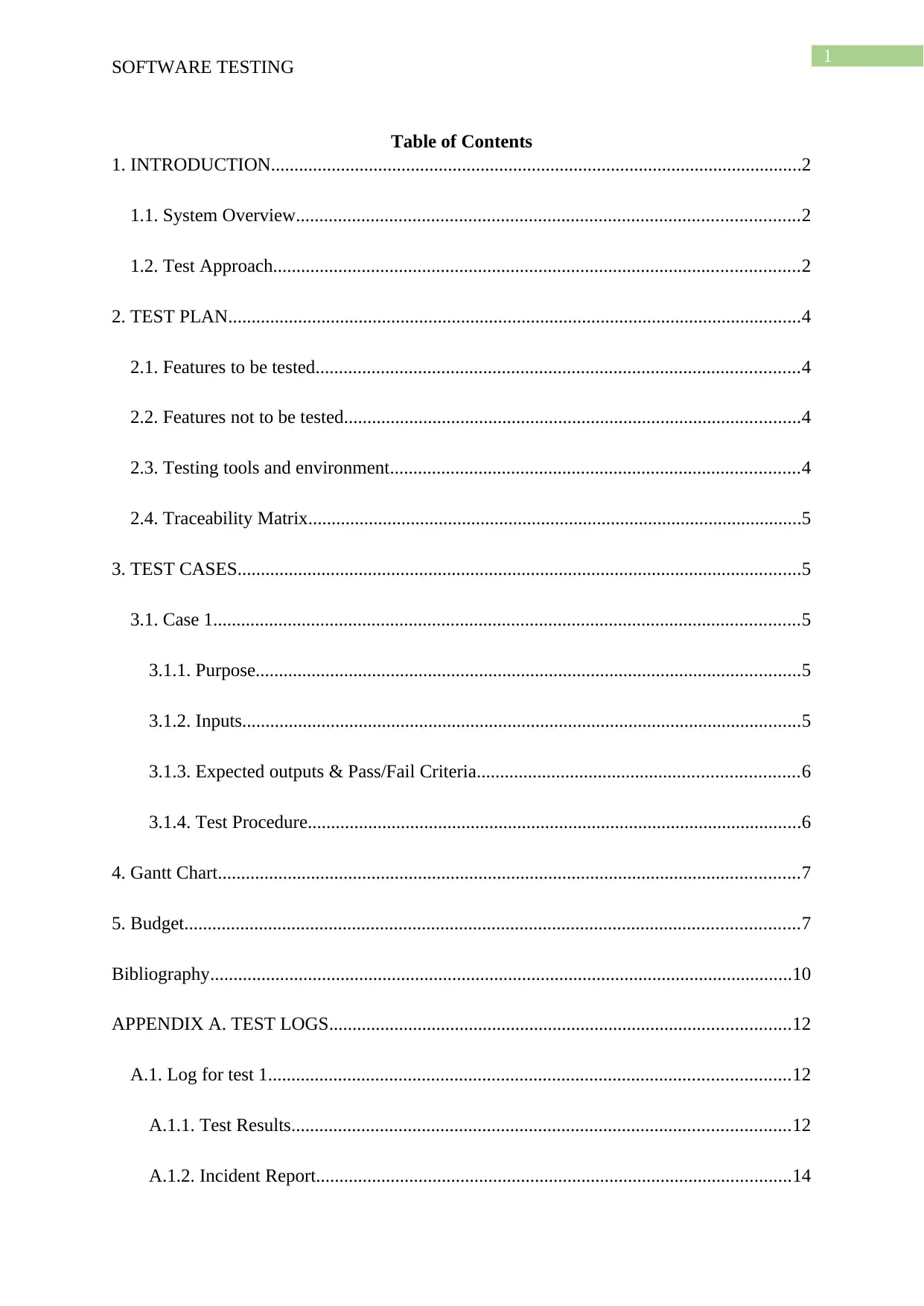
1
SOFTWARE TESTING
Table of Contents
1. INTRODUCTION..................................................................................................................2
1.1. System Overview............................................................................................................2
1.2. Test Approach.................................................................................................................2
2. TEST PLAN...........................................................................................................................4
2.1. Features to be tested........................................................................................................4
2.2. Features not to be tested..................................................................................................4
2.3. Testing tools and environment........................................................................................4
2.4. Traceability Matrix..........................................................................................................5
3. TEST CASES.........................................................................................................................5
3.1. Case 1..............................................................................................................................5
3.1.1. Purpose.....................................................................................................................5
3.1.2. Inputs........................................................................................................................5
3.1.3. Expected outputs & Pass/Fail Criteria.....................................................................6
3.1.4. Test Procedure..........................................................................................................6
4. Gantt Chart.............................................................................................................................7
5. Budget....................................................................................................................................7
Bibliography.............................................................................................................................10
APPENDIX A. TEST LOGS...................................................................................................12
A.1. Log for test 1................................................................................................................12
A.1.1. Test Results...........................................................................................................12
A.1.2. Incident Report......................................................................................................14
SOFTWARE TESTING
Table of Contents
1. INTRODUCTION..................................................................................................................2
1.1. System Overview............................................................................................................2
1.2. Test Approach.................................................................................................................2
2. TEST PLAN...........................................................................................................................4
2.1. Features to be tested........................................................................................................4
2.2. Features not to be tested..................................................................................................4
2.3. Testing tools and environment........................................................................................4
2.4. Traceability Matrix..........................................................................................................5
3. TEST CASES.........................................................................................................................5
3.1. Case 1..............................................................................................................................5
3.1.1. Purpose.....................................................................................................................5
3.1.2. Inputs........................................................................................................................5
3.1.3. Expected outputs & Pass/Fail Criteria.....................................................................6
3.1.4. Test Procedure..........................................................................................................6
4. Gantt Chart.............................................................................................................................7
5. Budget....................................................................................................................................7
Bibliography.............................................................................................................................10
APPENDIX A. TEST LOGS...................................................................................................12
A.1. Log for test 1................................................................................................................12
A.1.1. Test Results...........................................................................................................12
A.1.2. Incident Report......................................................................................................14
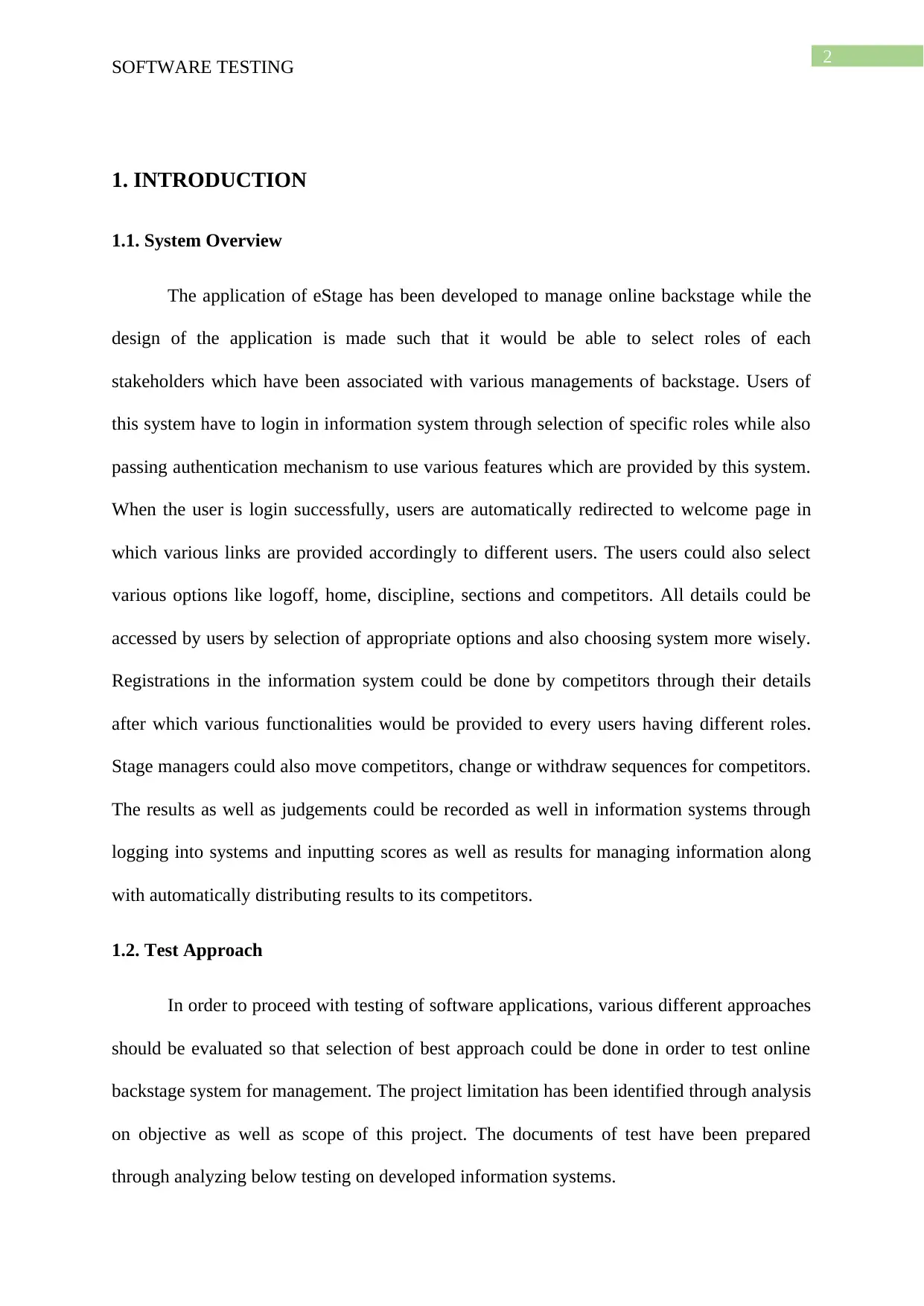
2
SOFTWARE TESTING
1. INTRODUCTION
1.1. System Overview
The application of eStage has been developed to manage online backstage while the
design of the application is made such that it would be able to select roles of each
stakeholders which have been associated with various managements of backstage. Users of
this system have to login in information system through selection of specific roles while also
passing authentication mechanism to use various features which are provided by this system.
When the user is login successfully, users are automatically redirected to welcome page in
which various links are provided accordingly to different users. The users could also select
various options like logoff, home, discipline, sections and competitors. All details could be
accessed by users by selection of appropriate options and also choosing system more wisely.
Registrations in the information system could be done by competitors through their details
after which various functionalities would be provided to every users having different roles.
Stage managers could also move competitors, change or withdraw sequences for competitors.
The results as well as judgements could be recorded as well in information systems through
logging into systems and inputting scores as well as results for managing information along
with automatically distributing results to its competitors.
1.2. Test Approach
In order to proceed with testing of software applications, various different approaches
should be evaluated so that selection of best approach could be done in order to test online
backstage system for management. The project limitation has been identified through analysis
on objective as well as scope of this project. The documents of test have been prepared
through analyzing below testing on developed information systems.
SOFTWARE TESTING
1. INTRODUCTION
1.1. System Overview
The application of eStage has been developed to manage online backstage while the
design of the application is made such that it would be able to select roles of each
stakeholders which have been associated with various managements of backstage. Users of
this system have to login in information system through selection of specific roles while also
passing authentication mechanism to use various features which are provided by this system.
When the user is login successfully, users are automatically redirected to welcome page in
which various links are provided accordingly to different users. The users could also select
various options like logoff, home, discipline, sections and competitors. All details could be
accessed by users by selection of appropriate options and also choosing system more wisely.
Registrations in the information system could be done by competitors through their details
after which various functionalities would be provided to every users having different roles.
Stage managers could also move competitors, change or withdraw sequences for competitors.
The results as well as judgements could be recorded as well in information systems through
logging into systems and inputting scores as well as results for managing information along
with automatically distributing results to its competitors.
1.2. Test Approach
In order to proceed with testing of software applications, various different approaches
should be evaluated so that selection of best approach could be done in order to test online
backstage system for management. The project limitation has been identified through analysis
on objective as well as scope of this project. The documents of test have been prepared
through analyzing below testing on developed information systems.
⊘ This is a preview!⊘
Do you want full access?
Subscribe today to unlock all pages.

Trusted by 1+ million students worldwide
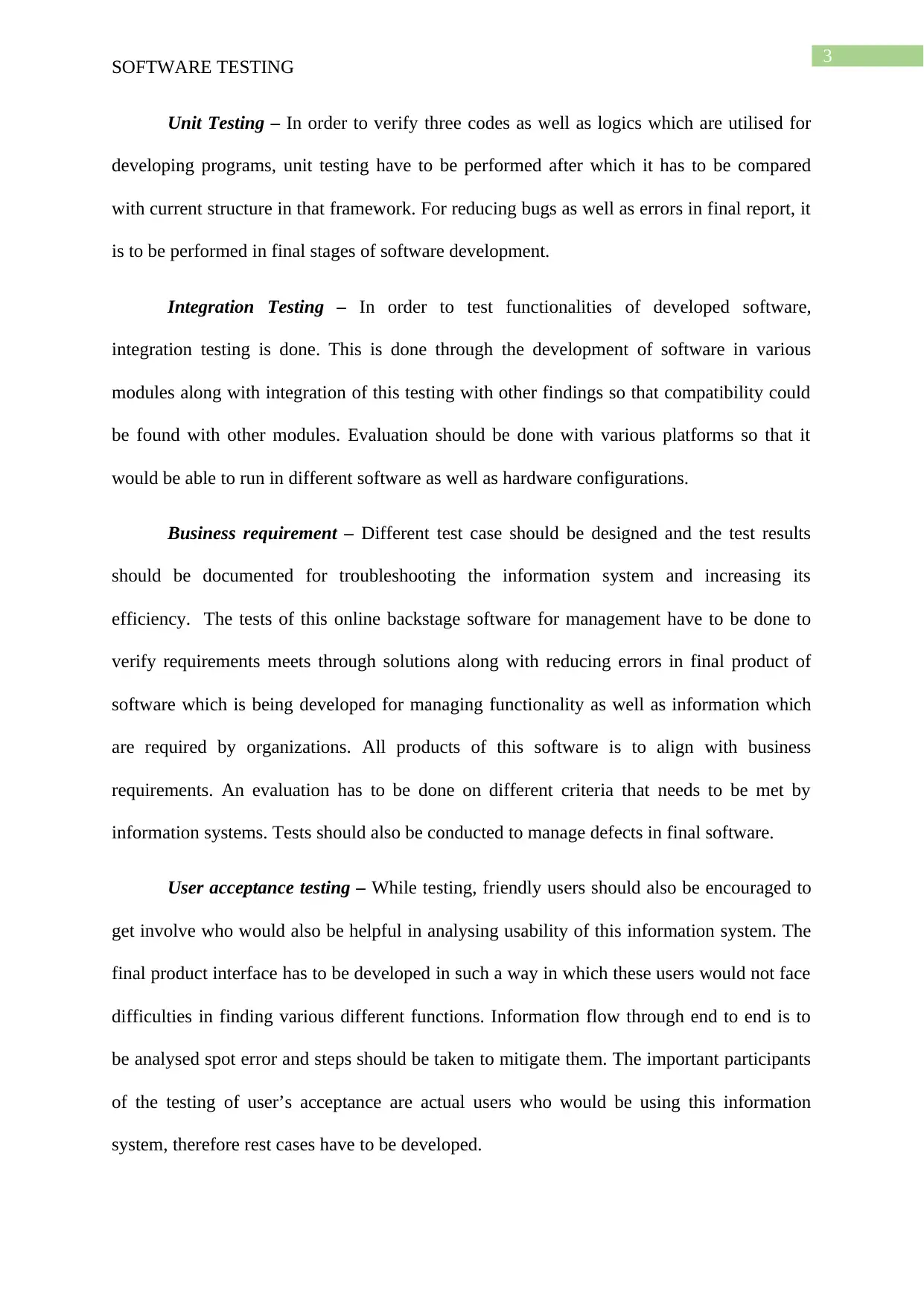
3
SOFTWARE TESTING
Unit Testing – In order to verify three codes as well as logics which are utilised for
developing programs, unit testing have to be performed after which it has to be compared
with current structure in that framework. For reducing bugs as well as errors in final report, it
is to be performed in final stages of software development.
Integration Testing – In order to test functionalities of developed software,
integration testing is done. This is done through the development of software in various
modules along with integration of this testing with other findings so that compatibility could
be found with other modules. Evaluation should be done with various platforms so that it
would be able to run in different software as well as hardware configurations.
Business requirement – Different test case should be designed and the test results
should be documented for troubleshooting the information system and increasing its
efficiency. The tests of this online backstage software for management have to be done to
verify requirements meets through solutions along with reducing errors in final product of
software which is being developed for managing functionality as well as information which
are required by organizations. All products of this software is to align with business
requirements. An evaluation has to be done on different criteria that needs to be met by
information systems. Tests should also be conducted to manage defects in final software.
User acceptance testing – While testing, friendly users should also be encouraged to
get involve who would also be helpful in analysing usability of this information system. The
final product interface has to be developed in such a way in which these users would not face
difficulties in finding various different functions. Information flow through end to end is to
be analysed spot error and steps should be taken to mitigate them. The important participants
of the testing of user’s acceptance are actual users who would be using this information
system, therefore rest cases have to be developed.
SOFTWARE TESTING
Unit Testing – In order to verify three codes as well as logics which are utilised for
developing programs, unit testing have to be performed after which it has to be compared
with current structure in that framework. For reducing bugs as well as errors in final report, it
is to be performed in final stages of software development.
Integration Testing – In order to test functionalities of developed software,
integration testing is done. This is done through the development of software in various
modules along with integration of this testing with other findings so that compatibility could
be found with other modules. Evaluation should be done with various platforms so that it
would be able to run in different software as well as hardware configurations.
Business requirement – Different test case should be designed and the test results
should be documented for troubleshooting the information system and increasing its
efficiency. The tests of this online backstage software for management have to be done to
verify requirements meets through solutions along with reducing errors in final product of
software which is being developed for managing functionality as well as information which
are required by organizations. All products of this software is to align with business
requirements. An evaluation has to be done on different criteria that needs to be met by
information systems. Tests should also be conducted to manage defects in final software.
User acceptance testing – While testing, friendly users should also be encouraged to
get involve who would also be helpful in analysing usability of this information system. The
final product interface has to be developed in such a way in which these users would not face
difficulties in finding various different functions. Information flow through end to end is to
be analysed spot error and steps should be taken to mitigate them. The important participants
of the testing of user’s acceptance are actual users who would be using this information
system, therefore rest cases have to be developed.
Paraphrase This Document
Need a fresh take? Get an instant paraphrase of this document with our AI Paraphraser
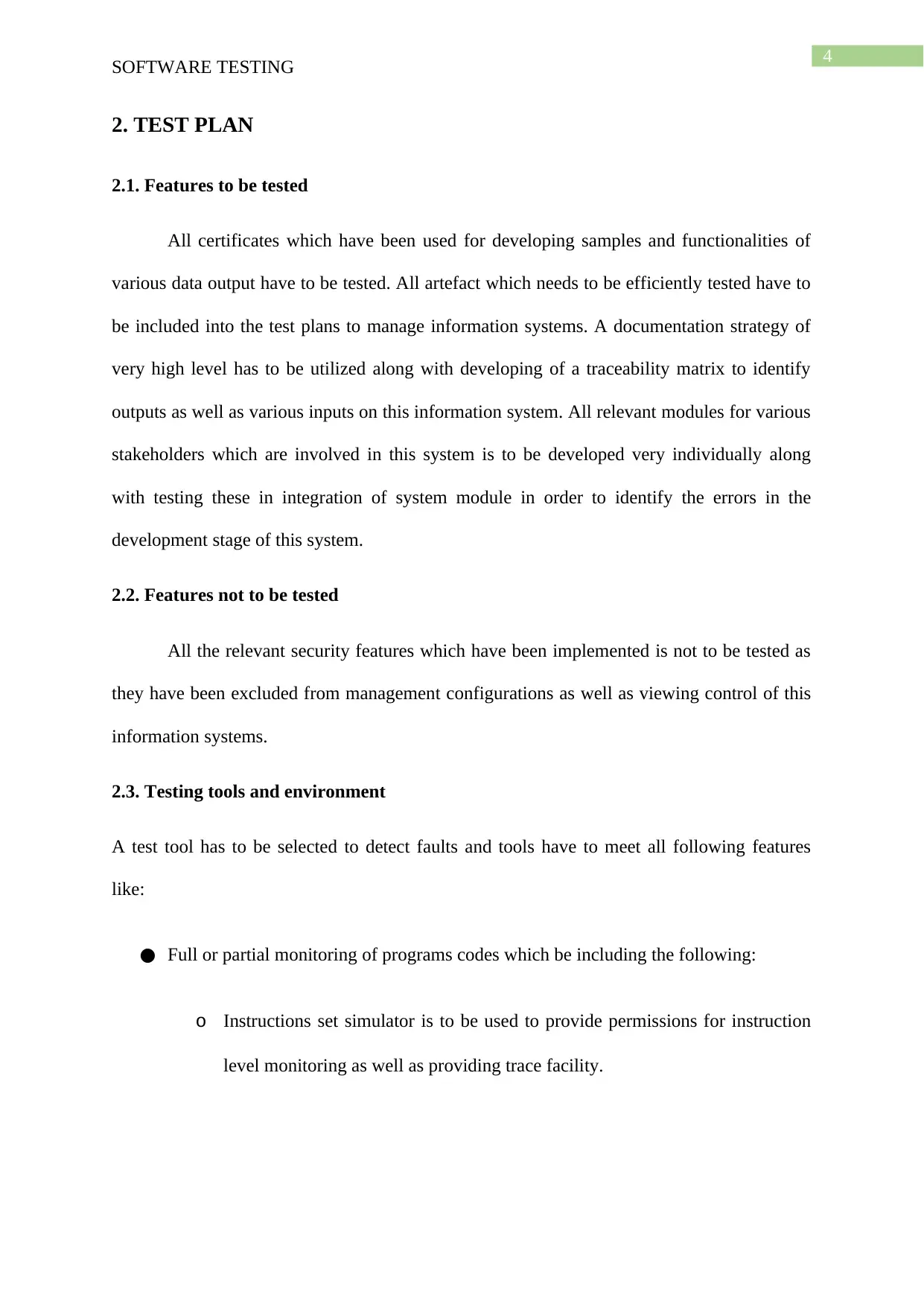
4
SOFTWARE TESTING
2. TEST PLAN
2.1. Features to be tested
All certificates which have been used for developing samples and functionalities of
various data output have to be tested. All artefact which needs to be efficiently tested have to
be included into the test plans to manage information systems. A documentation strategy of
very high level has to be utilized along with developing of a traceability matrix to identify
outputs as well as various inputs on this information system. All relevant modules for various
stakeholders which are involved in this system is to be developed very individually along
with testing these in integration of system module in order to identify the errors in the
development stage of this system.
2.2. Features not to be tested
All the relevant security features which have been implemented is not to be tested as
they have been excluded from management configurations as well as viewing control of this
information systems.
2.3. Testing tools and environment
A test tool has to be selected to detect faults and tools have to meet all following features
like:
● Full or partial monitoring of programs codes which be including the following:
o Instructions set simulator is to be used to provide permissions for instruction
level monitoring as well as providing trace facility.
SOFTWARE TESTING
2. TEST PLAN
2.1. Features to be tested
All certificates which have been used for developing samples and functionalities of
various data output have to be tested. All artefact which needs to be efficiently tested have to
be included into the test plans to manage information systems. A documentation strategy of
very high level has to be utilized along with developing of a traceability matrix to identify
outputs as well as various inputs on this information system. All relevant modules for various
stakeholders which are involved in this system is to be developed very individually along
with testing these in integration of system module in order to identify the errors in the
development stage of this system.
2.2. Features not to be tested
All the relevant security features which have been implemented is not to be tested as
they have been excluded from management configurations as well as viewing control of this
information systems.
2.3. Testing tools and environment
A test tool has to be selected to detect faults and tools have to meet all following features
like:
● Full or partial monitoring of programs codes which be including the following:
o Instructions set simulator is to be used to provide permissions for instruction
level monitoring as well as providing trace facility.
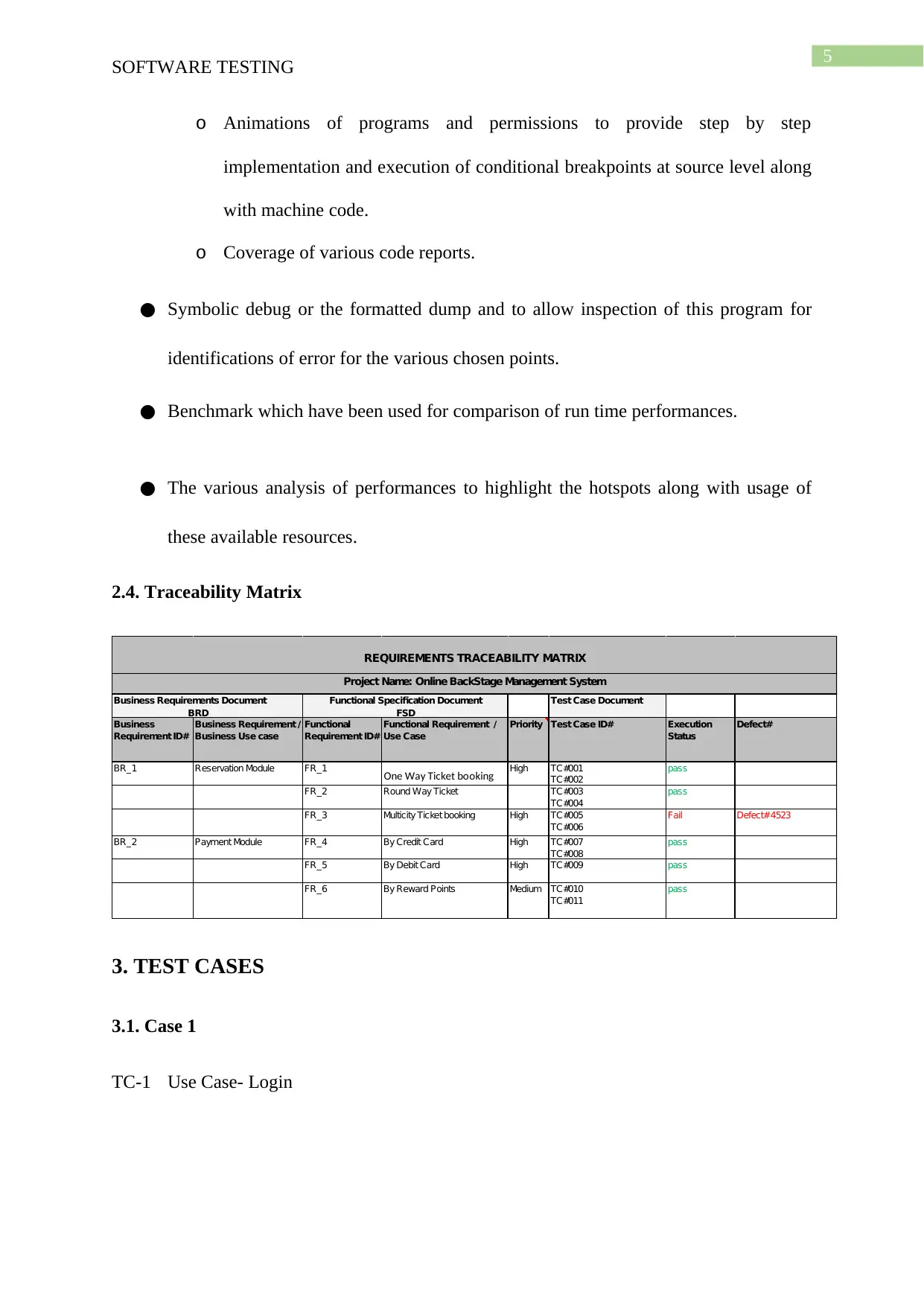
5
SOFTWARE TESTING
o Animations of programs and permissions to provide step by step
implementation and execution of conditional breakpoints at source level along
with machine code.
o Coverage of various code reports.
● Symbolic debug or the formatted dump and to allow inspection of this program for
identifications of error for the various chosen points.
● Benchmark which have been used for comparison of run time performances.
● The various analysis of performances to highlight the hotspots along with usage of
these available resources.
2.4. Traceability Matrix
Test Case Document
Business
Requirement ID#
Business Requirement /
Business Use case
Functional
Requirement ID#
Functional Requirement /
Use Case
Priority Test Case ID# Execution
Status
Defect#
BR_1 Reservation Module FR_1 One Way Ticket booking High TC#001
TC#002
pass
FR_2 Round Way Ticket TC#003
TC#004
pass
FR_3 Multicity Ticket booking High TC#005
TC#006
Fail Defect#4523
BR_2 Payment Module FR_4 By Credit Card High TC#007
TC#008
pass
FR_5 By Debit Card High TC#009 pass
FR_6 By Reward Points Medium TC#010
TC#011
pass
Project Name: Online BackStage Management System
REQUIREMENTS TRACEABILITY MATRIX
Business Requirements Document
BRD
Functional Specification Document
FSD
3. TEST CASES
3.1. Case 1
TC-1 Use Case- Login
SOFTWARE TESTING
o Animations of programs and permissions to provide step by step
implementation and execution of conditional breakpoints at source level along
with machine code.
o Coverage of various code reports.
● Symbolic debug or the formatted dump and to allow inspection of this program for
identifications of error for the various chosen points.
● Benchmark which have been used for comparison of run time performances.
● The various analysis of performances to highlight the hotspots along with usage of
these available resources.
2.4. Traceability Matrix
Test Case Document
Business
Requirement ID#
Business Requirement /
Business Use case
Functional
Requirement ID#
Functional Requirement /
Use Case
Priority Test Case ID# Execution
Status
Defect#
BR_1 Reservation Module FR_1 One Way Ticket booking High TC#001
TC#002
pass
FR_2 Round Way Ticket TC#003
TC#004
pass
FR_3 Multicity Ticket booking High TC#005
TC#006
Fail Defect#4523
BR_2 Payment Module FR_4 By Credit Card High TC#007
TC#008
pass
FR_5 By Debit Card High TC#009 pass
FR_6 By Reward Points Medium TC#010
TC#011
pass
Project Name: Online BackStage Management System
REQUIREMENTS TRACEABILITY MATRIX
Business Requirements Document
BRD
Functional Specification Document
FSD
3. TEST CASES
3.1. Case 1
TC-1 Use Case- Login
⊘ This is a preview!⊘
Do you want full access?
Subscribe today to unlock all pages.

Trusted by 1+ million students worldwide
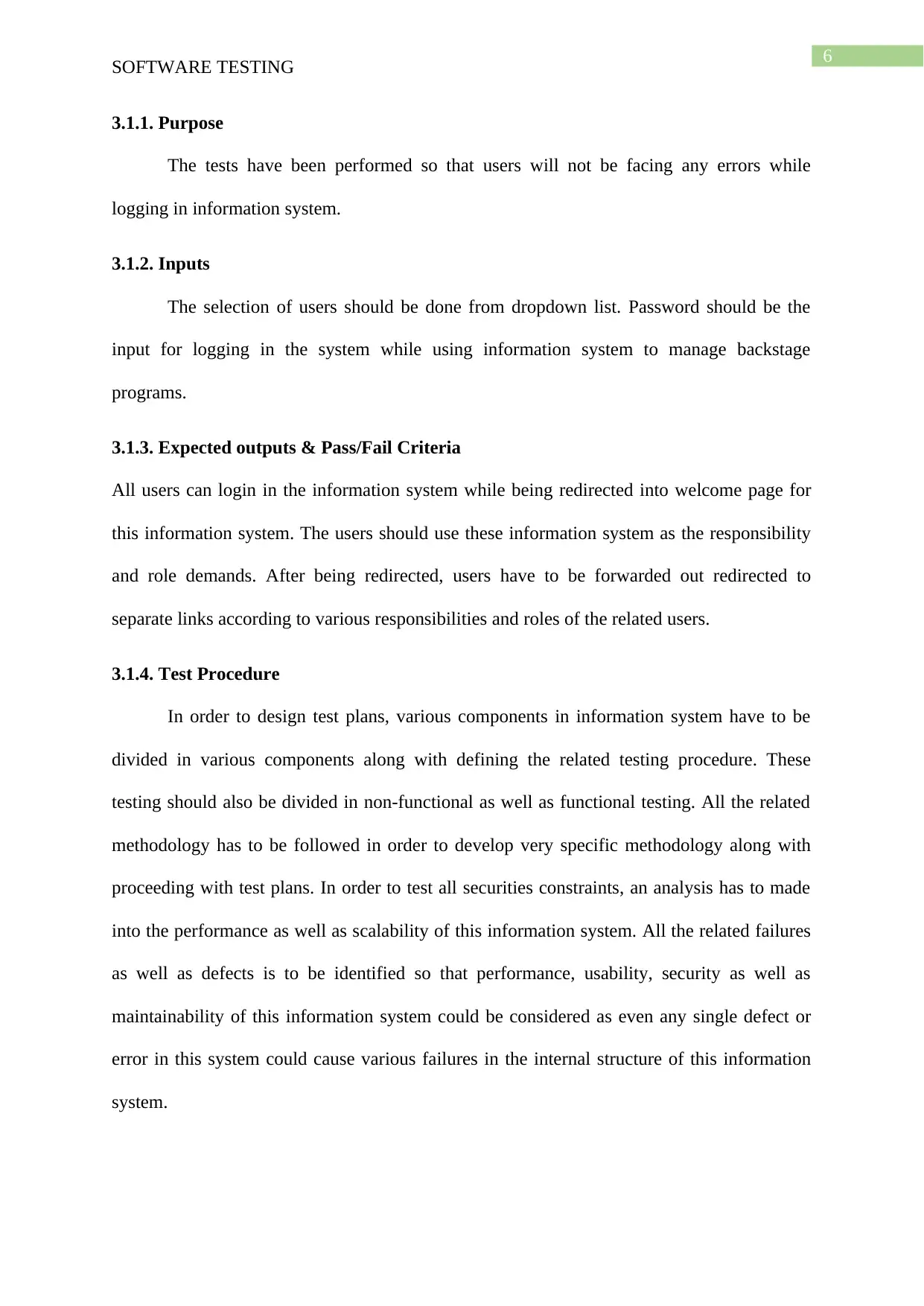
6
SOFTWARE TESTING
3.1.1. Purpose
The tests have been performed so that users will not be facing any errors while
logging in information system.
3.1.2. Inputs
The selection of users should be done from dropdown list. Password should be the
input for logging in the system while using information system to manage backstage
programs.
3.1.3. Expected outputs & Pass/Fail Criteria
All users can login in the information system while being redirected into welcome page for
this information system. The users should use these information system as the responsibility
and role demands. After being redirected, users have to be forwarded out redirected to
separate links according to various responsibilities and roles of the related users.
3.1.4. Test Procedure
In order to design test plans, various components in information system have to be
divided in various components along with defining the related testing procedure. These
testing should also be divided in non-functional as well as functional testing. All the related
methodology has to be followed in order to develop very specific methodology along with
proceeding with test plans. In order to test all securities constraints, an analysis has to made
into the performance as well as scalability of this information system. All the related failures
as well as defects is to be identified so that performance, usability, security as well as
maintainability of this information system could be considered as even any single defect or
error in this system could cause various failures in the internal structure of this information
system.
SOFTWARE TESTING
3.1.1. Purpose
The tests have been performed so that users will not be facing any errors while
logging in information system.
3.1.2. Inputs
The selection of users should be done from dropdown list. Password should be the
input for logging in the system while using information system to manage backstage
programs.
3.1.3. Expected outputs & Pass/Fail Criteria
All users can login in the information system while being redirected into welcome page for
this information system. The users should use these information system as the responsibility
and role demands. After being redirected, users have to be forwarded out redirected to
separate links according to various responsibilities and roles of the related users.
3.1.4. Test Procedure
In order to design test plans, various components in information system have to be
divided in various components along with defining the related testing procedure. These
testing should also be divided in non-functional as well as functional testing. All the related
methodology has to be followed in order to develop very specific methodology along with
proceeding with test plans. In order to test all securities constraints, an analysis has to made
into the performance as well as scalability of this information system. All the related failures
as well as defects is to be identified so that performance, usability, security as well as
maintainability of this information system could be considered as even any single defect or
error in this system could cause various failures in the internal structure of this information
system.
Paraphrase This Document
Need a fresh take? Get an instant paraphrase of this document with our AI Paraphraser
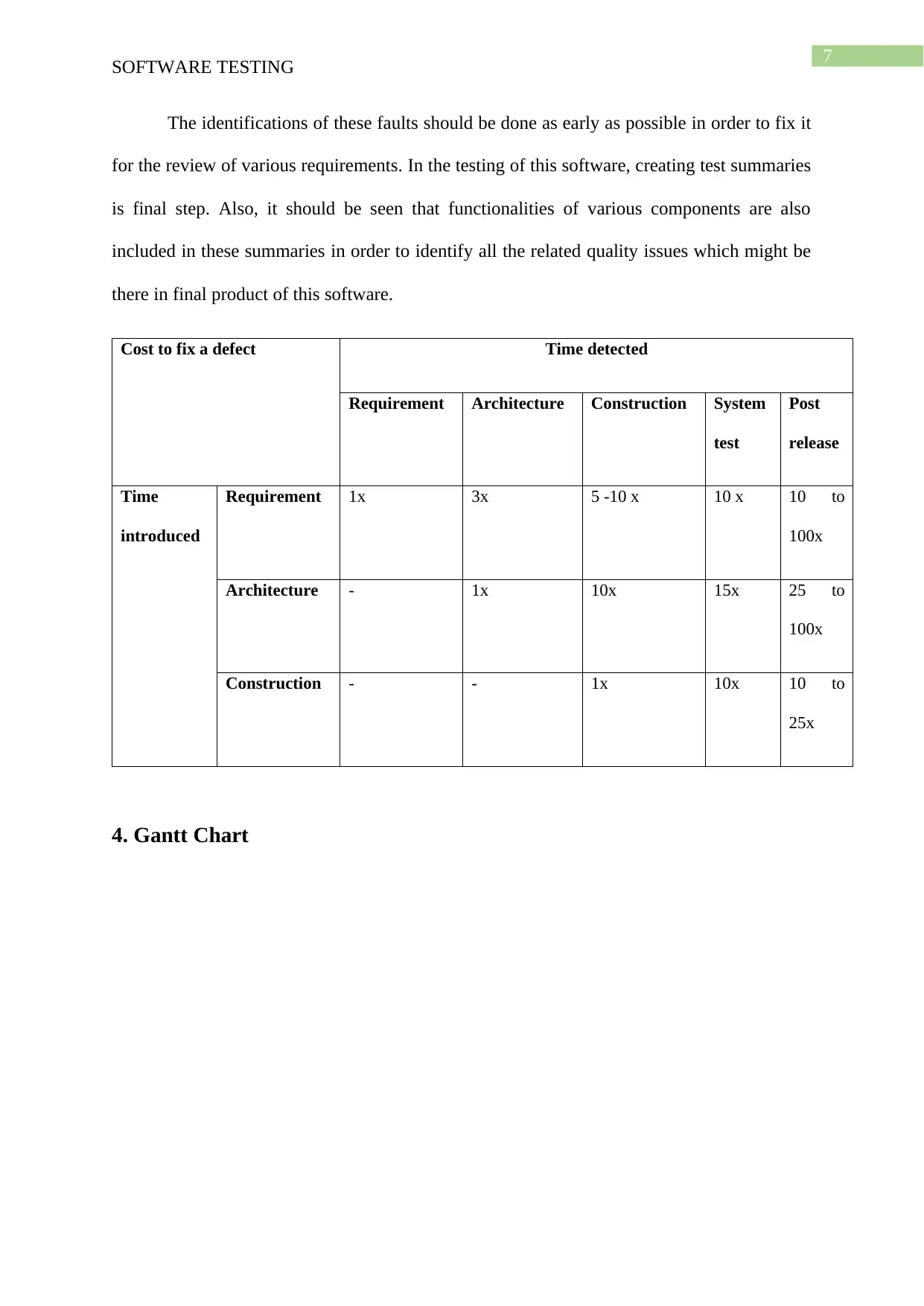
7
SOFTWARE TESTING
The identifications of these faults should be done as early as possible in order to fix it
for the review of various requirements. In the testing of this software, creating test summaries
is final step. Also, it should be seen that functionalities of various components are also
included in these summaries in order to identify all the related quality issues which might be
there in final product of this software.
Cost to fix a defect Time detected
Requirement Architecture Construction System
test
Post
release
Time
introduced
Requirement 1x 3x 5 -10 x 10 x 10 to
100x
Architecture - 1x 10x 15x 25 to
100x
Construction - - 1x 10x 10 to
25x
4. Gantt Chart
SOFTWARE TESTING
The identifications of these faults should be done as early as possible in order to fix it
for the review of various requirements. In the testing of this software, creating test summaries
is final step. Also, it should be seen that functionalities of various components are also
included in these summaries in order to identify all the related quality issues which might be
there in final product of this software.
Cost to fix a defect Time detected
Requirement Architecture Construction System
test
Post
release
Time
introduced
Requirement 1x 3x 5 -10 x 10 x 10 to
100x
Architecture - 1x 10x 15x 25 to
100x
Construction - - 1x 10x 10 to
25x
4. Gantt Chart
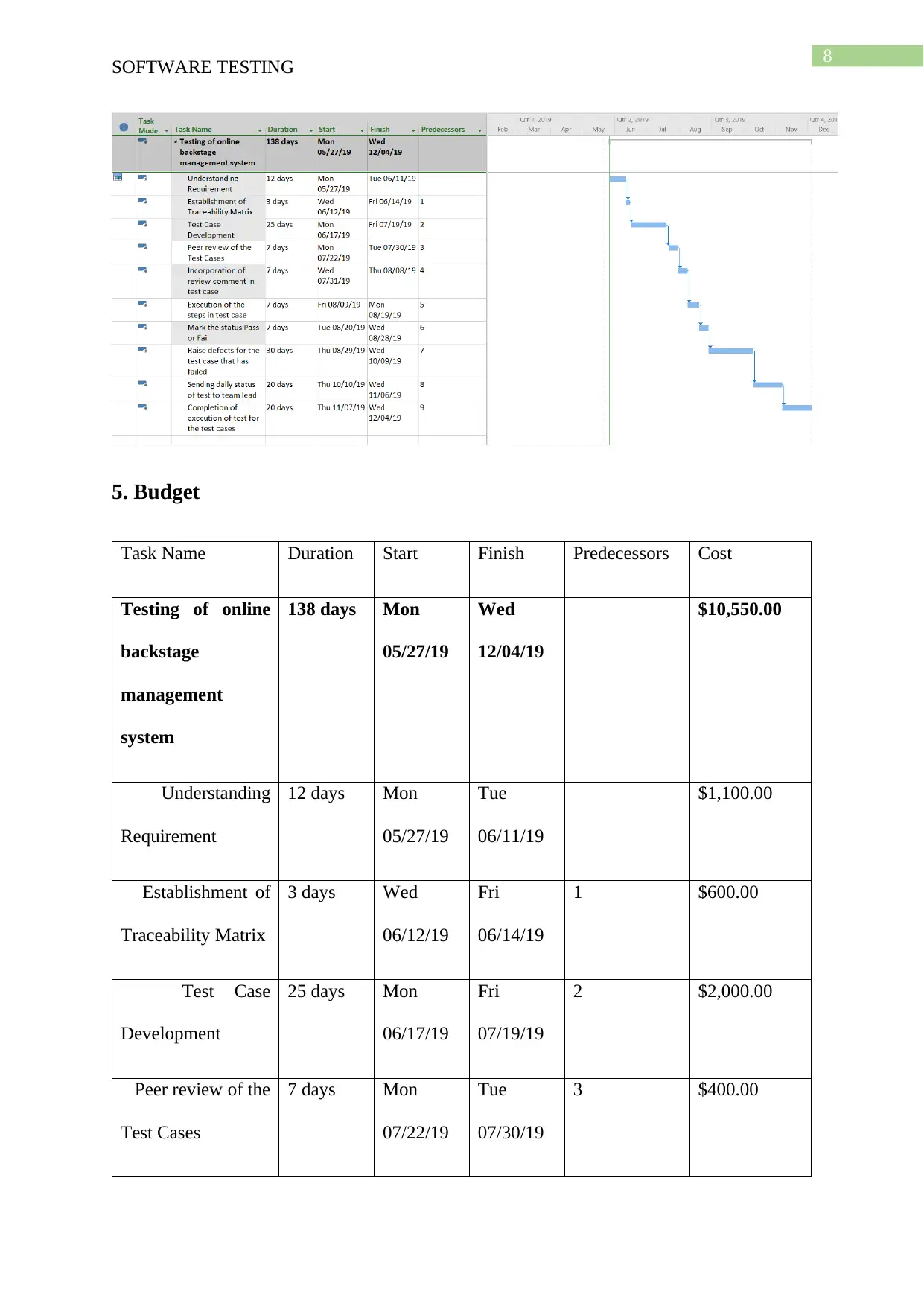
8
SOFTWARE TESTING
5. Budget
Task Name Duration Start Finish Predecessors Cost
Testing of online
backstage
management
system
138 days Mon
05/27/19
Wed
12/04/19
$10,550.00
Understanding
Requirement
12 days Mon
05/27/19
Tue
06/11/19
$1,100.00
Establishment of
Traceability Matrix
3 days Wed
06/12/19
Fri
06/14/19
1 $600.00
Test Case
Development
25 days Mon
06/17/19
Fri
07/19/19
2 $2,000.00
Peer review of the
Test Cases
7 days Mon
07/22/19
Tue
07/30/19
3 $400.00
SOFTWARE TESTING
5. Budget
Task Name Duration Start Finish Predecessors Cost
Testing of online
backstage
management
system
138 days Mon
05/27/19
Wed
12/04/19
$10,550.00
Understanding
Requirement
12 days Mon
05/27/19
Tue
06/11/19
$1,100.00
Establishment of
Traceability Matrix
3 days Wed
06/12/19
Fri
06/14/19
1 $600.00
Test Case
Development
25 days Mon
06/17/19
Fri
07/19/19
2 $2,000.00
Peer review of the
Test Cases
7 days Mon
07/22/19
Tue
07/30/19
3 $400.00
⊘ This is a preview!⊘
Do you want full access?
Subscribe today to unlock all pages.

Trusted by 1+ million students worldwide
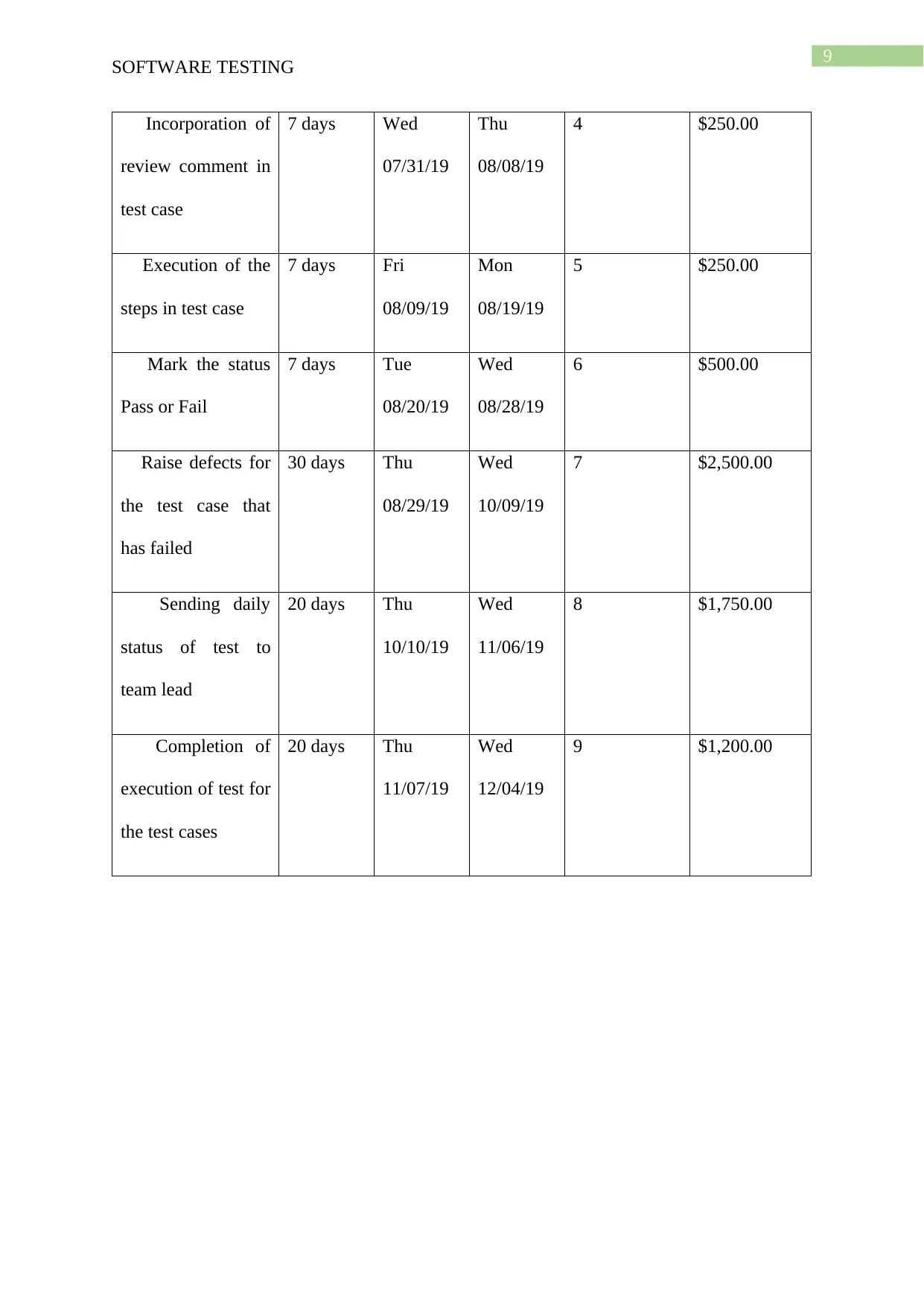
9
SOFTWARE TESTING
Incorporation of
review comment in
test case
7 days Wed
07/31/19
Thu
08/08/19
4 $250.00
Execution of the
steps in test case
7 days Fri
08/09/19
Mon
08/19/19
5 $250.00
Mark the status
Pass or Fail
7 days Tue
08/20/19
Wed
08/28/19
6 $500.00
Raise defects for
the test case that
has failed
30 days Thu
08/29/19
Wed
10/09/19
7 $2,500.00
Sending daily
status of test to
team lead
20 days Thu
10/10/19
Wed
11/06/19
8 $1,750.00
Completion of
execution of test for
the test cases
20 days Thu
11/07/19
Wed
12/04/19
9 $1,200.00
SOFTWARE TESTING
Incorporation of
review comment in
test case
7 days Wed
07/31/19
Thu
08/08/19
4 $250.00
Execution of the
steps in test case
7 days Fri
08/09/19
Mon
08/19/19
5 $250.00
Mark the status
Pass or Fail
7 days Tue
08/20/19
Wed
08/28/19
6 $500.00
Raise defects for
the test case that
has failed
30 days Thu
08/29/19
Wed
10/09/19
7 $2,500.00
Sending daily
status of test to
team lead
20 days Thu
10/10/19
Wed
11/06/19
8 $1,750.00
Completion of
execution of test for
the test cases
20 days Thu
11/07/19
Wed
12/04/19
9 $1,200.00
Paraphrase This Document
Need a fresh take? Get an instant paraphrase of this document with our AI Paraphraser
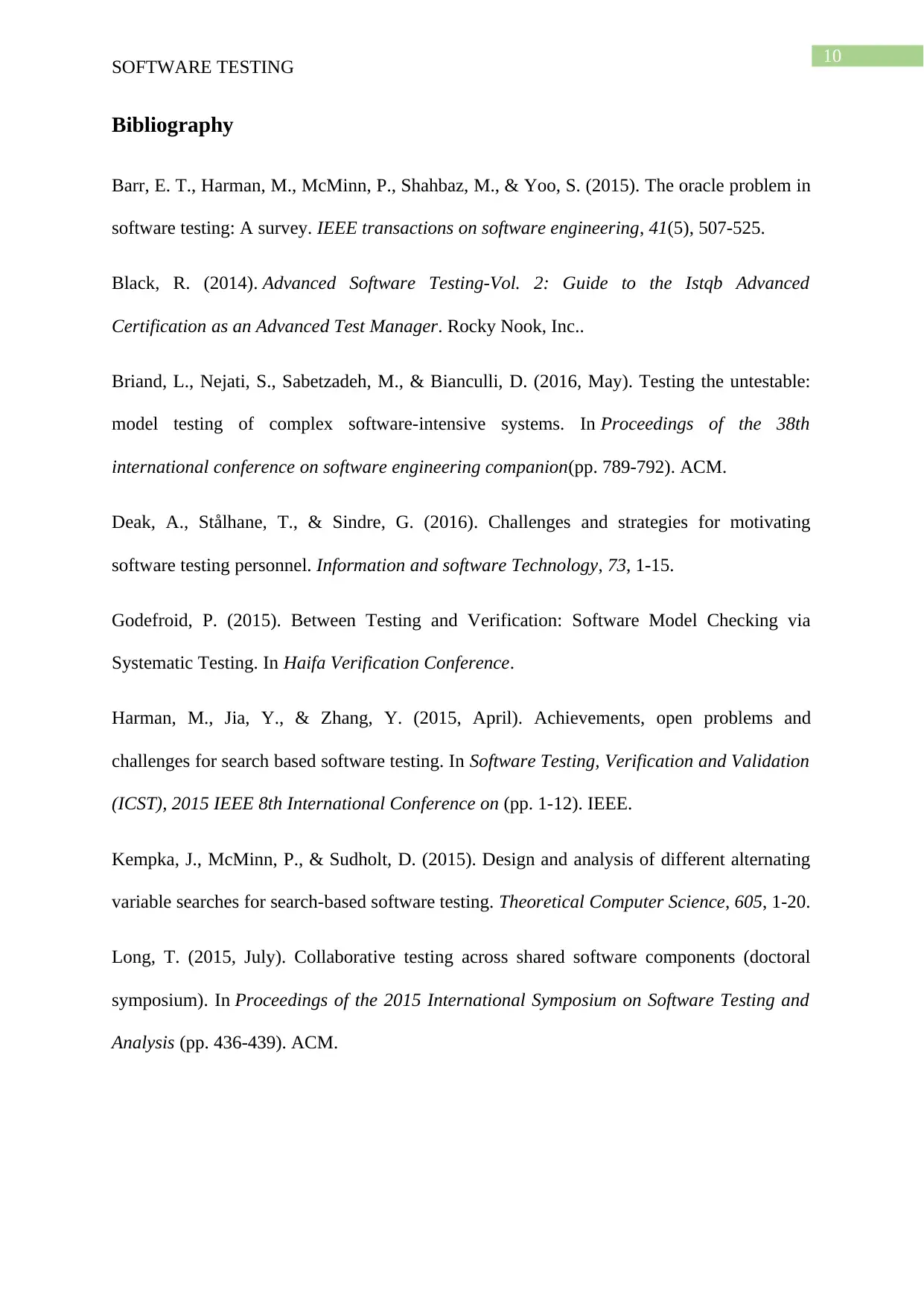
10
SOFTWARE TESTING
Bibliography
Barr, E. T., Harman, M., McMinn, P., Shahbaz, M., & Yoo, S. (2015). The oracle problem in
software testing: A survey. IEEE transactions on software engineering, 41(5), 507-525.
Black, R. (2014). Advanced Software Testing-Vol. 2: Guide to the Istqb Advanced
Certification as an Advanced Test Manager. Rocky Nook, Inc..
Briand, L., Nejati, S., Sabetzadeh, M., & Bianculli, D. (2016, May). Testing the untestable:
model testing of complex software-intensive systems. In Proceedings of the 38th
international conference on software engineering companion(pp. 789-792). ACM.
Deak, A., Stålhane, T., & Sindre, G. (2016). Challenges and strategies for motivating
software testing personnel. Information and software Technology, 73, 1-15.
Godefroid, P. (2015). Between Testing and Verification: Software Model Checking via
Systematic Testing. In Haifa Verification Conference.
Harman, M., Jia, Y., & Zhang, Y. (2015, April). Achievements, open problems and
challenges for search based software testing. In Software Testing, Verification and Validation
(ICST), 2015 IEEE 8th International Conference on (pp. 1-12). IEEE.
Kempka, J., McMinn, P., & Sudholt, D. (2015). Design and analysis of different alternating
variable searches for search-based software testing. Theoretical Computer Science, 605, 1-20.
Long, T. (2015, July). Collaborative testing across shared software components (doctoral
symposium). In Proceedings of the 2015 International Symposium on Software Testing and
Analysis (pp. 436-439). ACM.
SOFTWARE TESTING
Bibliography
Barr, E. T., Harman, M., McMinn, P., Shahbaz, M., & Yoo, S. (2015). The oracle problem in
software testing: A survey. IEEE transactions on software engineering, 41(5), 507-525.
Black, R. (2014). Advanced Software Testing-Vol. 2: Guide to the Istqb Advanced
Certification as an Advanced Test Manager. Rocky Nook, Inc..
Briand, L., Nejati, S., Sabetzadeh, M., & Bianculli, D. (2016, May). Testing the untestable:
model testing of complex software-intensive systems. In Proceedings of the 38th
international conference on software engineering companion(pp. 789-792). ACM.
Deak, A., Stålhane, T., & Sindre, G. (2016). Challenges and strategies for motivating
software testing personnel. Information and software Technology, 73, 1-15.
Godefroid, P. (2015). Between Testing and Verification: Software Model Checking via
Systematic Testing. In Haifa Verification Conference.
Harman, M., Jia, Y., & Zhang, Y. (2015, April). Achievements, open problems and
challenges for search based software testing. In Software Testing, Verification and Validation
(ICST), 2015 IEEE 8th International Conference on (pp. 1-12). IEEE.
Kempka, J., McMinn, P., & Sudholt, D. (2015). Design and analysis of different alternating
variable searches for search-based software testing. Theoretical Computer Science, 605, 1-20.
Long, T. (2015, July). Collaborative testing across shared software components (doctoral
symposium). In Proceedings of the 2015 International Symposium on Software Testing and
Analysis (pp. 436-439). ACM.
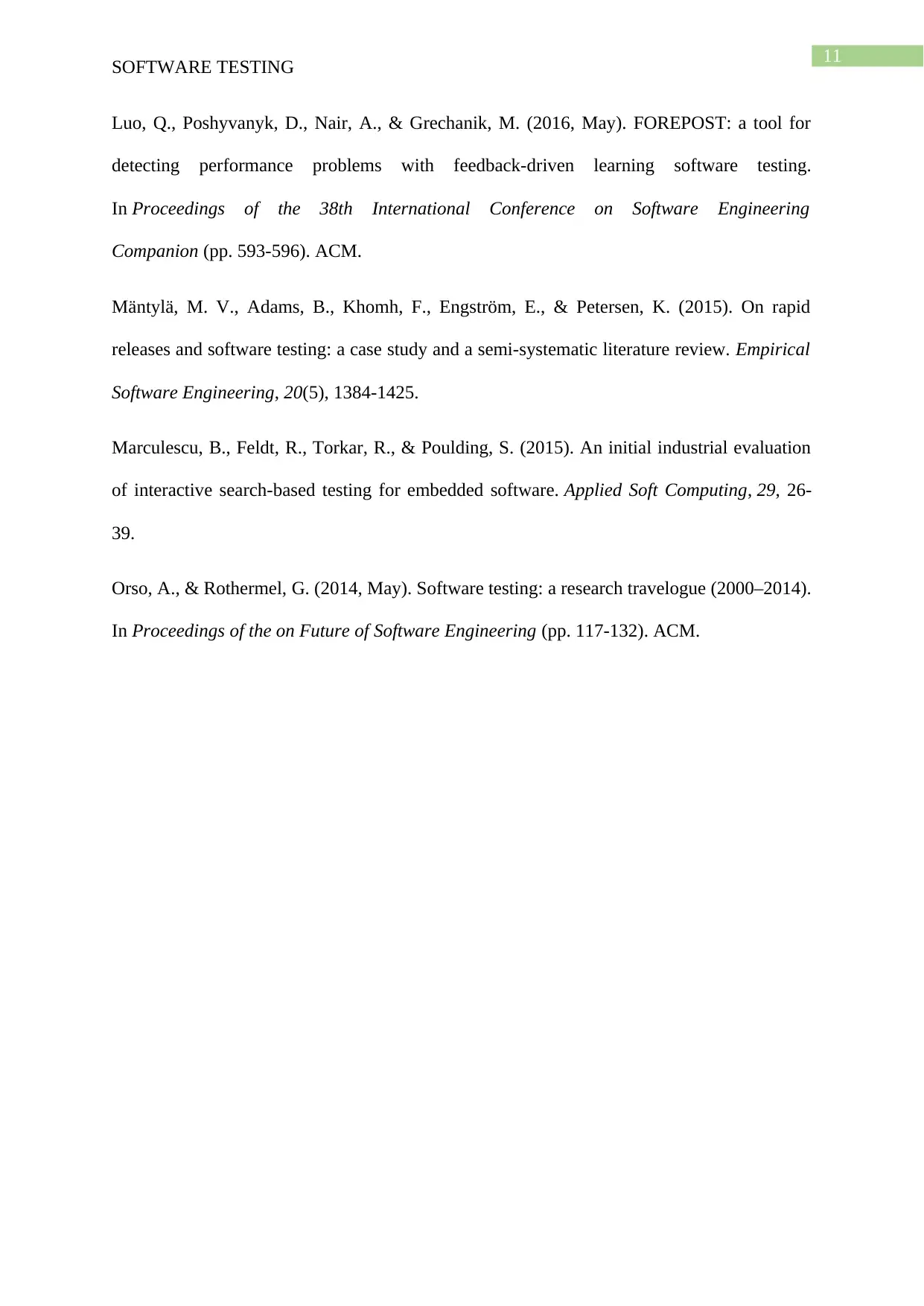
11
SOFTWARE TESTING
Luo, Q., Poshyvanyk, D., Nair, A., & Grechanik, M. (2016, May). FOREPOST: a tool for
detecting performance problems with feedback-driven learning software testing.
In Proceedings of the 38th International Conference on Software Engineering
Companion (pp. 593-596). ACM.
Mäntylä, M. V., Adams, B., Khomh, F., Engström, E., & Petersen, K. (2015). On rapid
releases and software testing: a case study and a semi-systematic literature review. Empirical
Software Engineering, 20(5), 1384-1425.
Marculescu, B., Feldt, R., Torkar, R., & Poulding, S. (2015). An initial industrial evaluation
of interactive search-based testing for embedded software. Applied Soft Computing, 29, 26-
39.
Orso, A., & Rothermel, G. (2014, May). Software testing: a research travelogue (2000–2014).
In Proceedings of the on Future of Software Engineering (pp. 117-132). ACM.
SOFTWARE TESTING
Luo, Q., Poshyvanyk, D., Nair, A., & Grechanik, M. (2016, May). FOREPOST: a tool for
detecting performance problems with feedback-driven learning software testing.
In Proceedings of the 38th International Conference on Software Engineering
Companion (pp. 593-596). ACM.
Mäntylä, M. V., Adams, B., Khomh, F., Engström, E., & Petersen, K. (2015). On rapid
releases and software testing: a case study and a semi-systematic literature review. Empirical
Software Engineering, 20(5), 1384-1425.
Marculescu, B., Feldt, R., Torkar, R., & Poulding, S. (2015). An initial industrial evaluation
of interactive search-based testing for embedded software. Applied Soft Computing, 29, 26-
39.
Orso, A., & Rothermel, G. (2014, May). Software testing: a research travelogue (2000–2014).
In Proceedings of the on Future of Software Engineering (pp. 117-132). ACM.
⊘ This is a preview!⊘
Do you want full access?
Subscribe today to unlock all pages.

Trusted by 1+ million students worldwide
1 out of 16
Related Documents
Your All-in-One AI-Powered Toolkit for Academic Success.
+13062052269
info@desklib.com
Available 24*7 on WhatsApp / Email
![[object Object]](/_next/static/media/star-bottom.7253800d.svg)
Unlock your academic potential
Copyright © 2020–2025 A2Z Services. All Rights Reserved. Developed and managed by ZUCOL.





